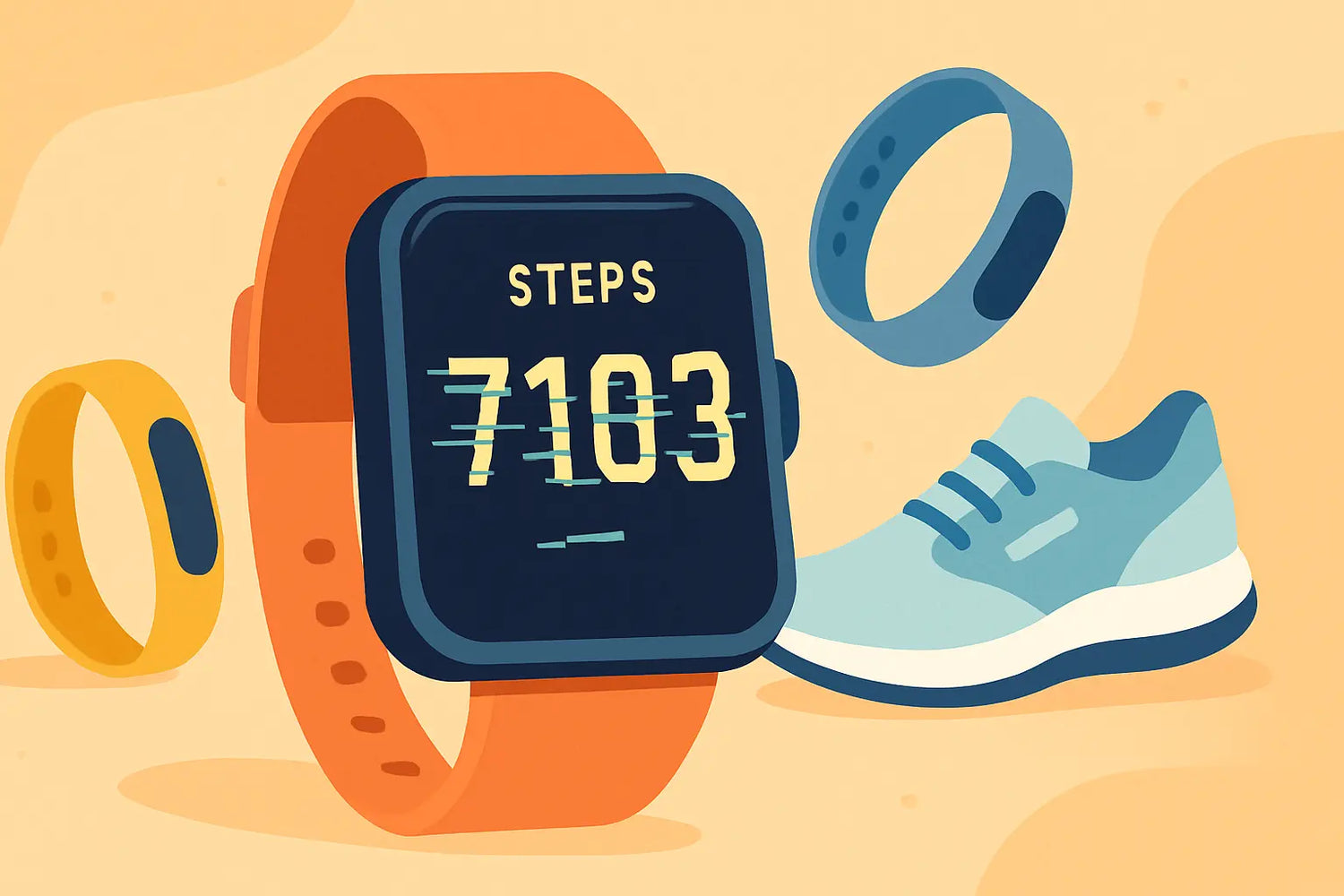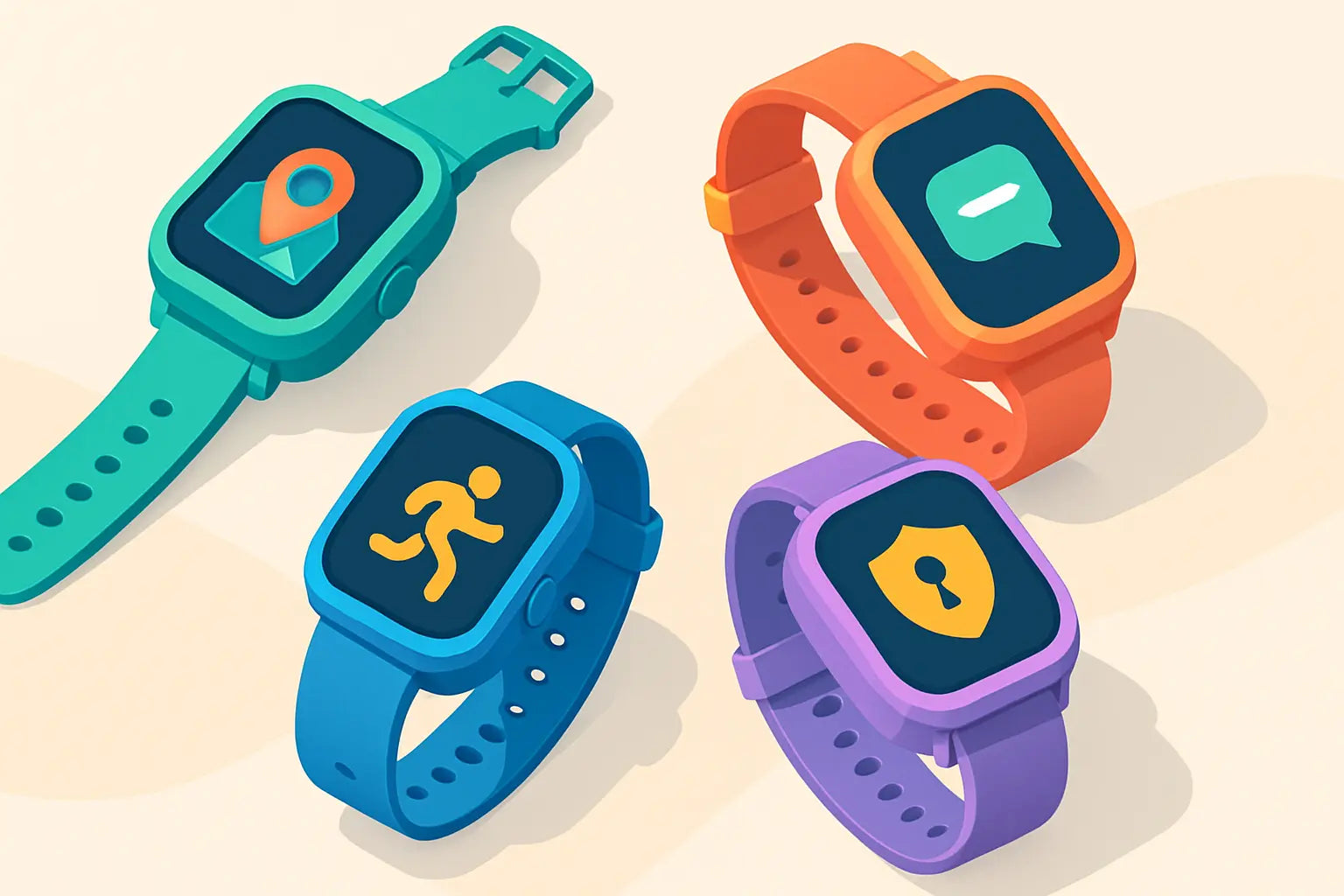Step tracking drifts when your watch cannot reliably detect your arm movement, stride length, or pace, or when settings and strap fit are off. Most users can restore 90 to 98 percent accuracy by tightening the strap, recalibrating outdoors with GPS, updating firmware, and avoiding activities that mask arm swing.
Why won't my smartwatch count steps correctly?
Wrist placement and strap fit
A watch that rides up and down your wrist confuses the accelerometer and gyroscope. Aim for a snug fit - one to two finger widths above the wrist bone. In lab tests, loose bands increase false steps by 5 to 12 percent during brisk walking.
If your band is worn or loose, consider upgrading with Apple Watch straps and matching Apple accessories to stabilise the device.
Arm swing variability
Pushing a pram, carrying bags, or keeping hands in pockets reduces arm swing, so algorithms may miss steps. On the flip side, vigorous hand gestures can add false positives. Expect undercounts up to 25 percent when pushing a trolley, and small overcounts during animated conversations.
Stride length and pace changes
Step algorithms estimate distance using stride length, which changes with speed and terrain. At 3 mph walking, many users have a stride near 0.6 to 0.75 m; during slow indoor shuffles it can drop below 0.5 m. Without calibration, this can skew total steps by 5 to 15 percent.
Software settings and permissions
Motion permissions, wrist orientation, and dominant hand settings affect classification accuracy. A mismatch between dominant wrist and setting can reduce sensitivity by 3 to 5 percent. Disabling location services prevents GPS-assisted calibration that refines your stride length over time.
Battery saving and sensor sampling
Low-power modes often reduce sensor sampling rates, which can miss shorter step impulses. Many wearables sample movement between 25 and 100 Hz; dropping from 50 Hz to 25 Hz can slightly undercount at faster cadences above 160 steps per minute. Keep enough charge to avoid aggressive power saving.
Firmware and algorithm updates
Manufacturers refine gait models via updates. After major updates, some users see temporary differences as the watch relearns patterns. A quick outdoor calibration walk usually stabilises results within one or two activities.
Model-specific considerations in 2025
Apple Watch 11 step tracking notes
Apple Watch 11 uses a 3-axis accelerometer and gyroscope with on-device machine learning to classify steps. Apple reports improved gait detection in mixed indoor-outdoor walks compared with earlier generations. Typical accuracy in independent tests falls within 3 to 8 percent of manual counts when worn snugly.
Enable Motion Calibration & Distance on iPhone to allow continuous refinement. For treadmill sessions, record a Walking workout for 20 minutes to anchor cadence and stride length to speed.
Samsung Galaxy Watch 8 and 9 details
Galaxy Watch 8 and 9 combine accelerometer data with cadence smoothing in Samsung Health. The watches can prioritise either phone or watch steps; using the watch as the primary source tends to be more consistent. Expect 5 to 10 percent error indoors, tightening outdoors with GPS-enabled activities.
High accuracy tracking is best with continuous heart rate and location active during calibration sessions. Check that Workout detection is enabled so the watch applies the right model when you speed up.
Garmin Venu 3 and Forerunner 965 notes
Garmin wearables maintain strong accuracy for runners and walkers thanks to pace-linked stride models. Venu 3 and Forerunner 965 typically land within 3 to 7 percent of manual counts outdoors. Indoors without GPS, stride settings and arm movement have a larger impact.
Garmin Connect lets you edit personal stride length if you know your typical figures from a measured track. Recording an outdoor walk or run quickly improves distance and step precision.
How do I recalibrate step tracking on smartwatch?
Calibrate Apple Watch 11
On your iPhone, open Settings - Privacy & Security - Location Services - System Services, then enable Motion Calibration & Distance. On Apple Watch, ensure your wrist orientation and dominant hand are correct in the Watch app.
Go outside on a flat route with good GPS. Start an Outdoor Walk workout and walk 20 minutes at your natural pace, keeping a steady cadence around 100 to 120 steps per minute.
If needed, reset calibration in Watch app - Privacy - Reset Fitness Calibration Data. Repeat the 20-minute walk and check results over the next day.
Calibrate Samsung Galaxy Watch 8 and 9
In Galaxy Wearable, confirm watch is the priority step source if you prefer wrist data. Verify Location is on and Samsung Health has required permissions.
Record an Outdoor Walk for 15 to 20 minutes on level ground. Keep the strap snug; then compare steps with a manual count over a 1 km segment to validate.
If counts remain off, toggle auto-detect workouts off and on, reboot the watch, and repeat the calibration walk. Update firmware via Galaxy Wearable.
Calibrate Garmin Venu 3 and Forerunner 965
Enable GPS and record a 20-minute Walk activity at typical pace. After syncing, Garmin Connect refines your stride mapping for walking and running.
Optionally set a custom stride length: Garmin Connect - More - Settings - User Settings. Measure over 400 m on a track to derive your average stride for walking and running.
Practical accuracy - what should you expect?
Typical error ranges by situation
Outdoor walks with GPS-assisted calibration generally show 2 to 6 percent error. Indoor office days with frequent arm pauses may show 5 to 12 percent error. Treadmills can swing 3 to 15 percent depending on handrail use and belt speed stability.
| Factor | Effect on steps | Apple Watch 11 tip | Galaxy Watch 8/9 tip | Garmin Venu 3 tip |
|---|---|---|---|---|
| Loose strap | False steps increase | Tighten 1-2 finger rule | Use sport band holes | Switch to snug strap |
| Hands in pockets | Undercount up to 25% | Record Walking workout | Enable auto-detect | Use activity profile |
| Treadmill handrail | Undercount common | Hold lightly or swing | Swing one arm freely | Set custom stride |
| Low-power mode | Miss short steps | Disable during walks | Keep battery above 20% | Use normal mode |
| No GPS history | Poor stride estimate | 20 min outdoor walk | 15-20 min walk log | 20 min walk with GPS |
Environment and activity nuances
Terrain, footwear, and cadence
Hills shorten stride and increase vertical oscillation, which some algorithms misread as extra steps. Soft-soled shoes dampen impact and may reduce detection sensitivity slightly. Very slow cadences below 80 steps per minute often undercount indoors.
Phone plus watch step merging
Some ecosystems merge phone and watch steps, which can double-count if both detect motion simultaneously. Choose a single source in settings to avoid duplication. Reconcile daily totals by checking hourly graphs for spikes that indicate merges.
Quick signs your count is off
- Identical hours show spikes
- Treadmill totals feel low
- Big swings after updates
- Battery saver enabled
Troubleshooting checklist
- Confirm wrist setting
- Tighten the strap
- Update firmware
- Reboot the watch
- Record outdoor walk
- Review app permissions
Data-backed expectations
What counts as normal variance
Across community logs, most modern wearables cluster within 5 to 10 percent of manual tallies on typical UK commutes. A difference of 300 to 800 steps on a 10,000-step day is common and not necessarily a fault. Consistent deviations beyond 15 percent signal configuration or wearing issues.
How to validate at home
Pick a flat path of 500 m and count steps manually while recording a Walking workout. Compare totals; repeat three times to average results and avoid one-off anomalies. Aim for under 5 percent difference after calibration.
FAQ
Why does my watch add steps when I am typing?
Rapid wrist micro-movements can mimic step signatures at certain sampling thresholds. Tighten the strap and rest your wrists periodically to reduce misclassification. Short bursts will have minimal impact on daily totals.
Is GPS required for accurate steps?
No, steps are primarily accelerometer-based. GPS helps calibrate stride length and improves distance mapping, indirectly stabilising step counts. Occasional outdoor calibration is sufficient for primarily indoor users.
Why do treadmill steps differ from the machine?
Handrail use and belt speed calibration affect both readings differently. Your watch relies on arm swing and cadence while the treadmill uses belt rotations. Hold the rail lightly or swing one arm, and perform a 20-minute calibration walk before indoor sessions.
Should I wear my watch on my dominant wrist?
Either wrist is fine if the setting matches. Dominant wrists can produce higher acceleration peaks, which algorithms compensate for when set correctly. Update wrist preference in your app if you switch sides.
Conclusion
Your smartwatch miscounts steps when strap fit, arm swing, stride calibration, or settings disrupt the motion pattern it expects. Tighten the band, confirm wrist and permissions, update firmware, and perform a 15 to 20 minute outdoor calibration walk. With these steps, Apple Watch 11, Galaxy Watch 8 or 9, and Garmin models typically return to 90 to 98 percent accuracy.




Leave a comment
All comments are moderated before being published.
This site is protected by hCaptcha and the hCaptcha Privacy Policy and Terms of Service apply.